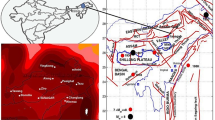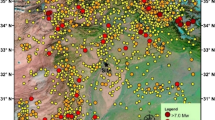Abstract
At 22:55 on the 17th of June 2019, an Ms 6.0 earthquake hit Changning County, Sichuan Province, China. On the second day, an emergency survey group arrived at the epicentre, and an earthquake monitoring profile was established. Two aftershocks with magnitudes of Ms 5.4 and Ms 5.6 were captured. Some main conclusions are as follows: (1) Compared with the high mountainous and canyon districts in Northwest Sichuan Province, coseismic geological disasters that occur in hilly districts in South Sichuan Province occur on a much smaller scale, usually less than 1000 m3. The types of disasters are mainly rock falls and rock avalanches, while landslides are rare. (2) The Ms 5.4 aftershock reveals that the amplification effects of topography (the mountaintop) and site conditions (soil site) exist under natural seismic loads, and the latter is stronger. The amplification effects are mainly manifested as the amplification of peak ground acceleration (PGA) and Arias intensity in the E‒W, N‒S and up–down (U–D) directions. Moreover, because of the E‒W strike of the mountain, the PGA values and Arias intensity in the N‒S direction are the largest. (3) The Ms 5.6 aftershock reveals that the edge of the mountaintop has a stronger seismic response than the centre part, which is mainly manifested as a further increase in the PGA and Arias intensity; this pattern is consistent with the phenomenon that coseismic disasters tend to originate at the edges of mountaintops.
















Similar content being viewed by others
Change history
21 September 2022
A Correction to this paper has been published: https://doi.org/10.1007/s10064-022-02948-w
References
Ashford A, Sitar N, Lysmer J, Deng N (1997) Topographic effects on the seismic response of steep slopes. Bull Seismol Soc Am 87(3):701–709
Celebi M (1987) Topography and geologic amplification determined from strong-motion and after shock records of 3 March 1985 Chile earthquake. Bull Seismol Soc Am 77:1147–1107
Hartzell SH, Carver DL, King KW (1994) Initial investigation of site and topographic effects at Robinwood Ridge, California. Bull Seismol Soc Am 84(5):1336–1349
He JX, Qi SW, Wang YS et al (2020) Seismic response of the Lengzhuguan slope caused by topographic and geological effects. Eng Geo 265:105431. https://doi.org/10.1016/j.enggeo.2019.105431
He JX, Qi SW, Zhang ZF et al (2021) Seismic response characteristics and deformation evaluation of the bedding rock slope using a large-scale shaking table. Landslides 18(8):2835–2853
He JX, Wang YS, Luo YH et al (2015) Monitoring result analysis of slope seismic response during the Kangding Ms6.3 earthquake. J Eng Geo 23(03):383–393 (In Chinese)
He JX, Fu HY, Zhang YB et al (2022) The effect of surficial soil on the seismic response characteristics and failure pattern of step-like slopes. Soil Dyn Earthq Eng 161:107441. https://doi.org/10.1016/j.soildyn.2022.107441
Huang RQ, Li WL (2009) Analysis of the geo-hazards triggered by the 12 May 2008 Wenchuan earthquake, China. Bull Eng Geol Environ 68(3):363–371
Huang RQ, Li WL (2014) Post-earthquake landsliding and long-term impacts in the Wenchuan earthquake area. China. Eng Geol 182(Part b):111–120
Huang RQ, Pei XJ, Fan XM et al (2012) The characteristics and failure mechanism of the largest landslide triggered by the Wenchuan earthquake, May 12, 2008, China. Landslides 9(1):131–142
Kargel S, Leonard GJ, Shugar DH, Haritashya UK (2016) Geomorphic and geologic controls of geohazards induced by Nepal’s 2015 Gorkha earthquake. Science 351(6269):140–151
Keeper DK (1984) Landslides caused by earthquakes. Geol Soc Am Bull 95(4):406–421
Korup O, Clague JJ, Hermanns RL et al (2007) Giant landslides, topography and erosion. Earth Planet Sci Lett 261:578–589
Liu HX, Xu Q, Li YQ (2014) Effect of lithology and structure on seismic response of steep slope in a shaking table test. J Mt Sci 2(13):371–383
Luo YH, Del Gaudio V, Huang RQ et al (2014) Evidence of hillslope directional amplification from accelerometer recordings at Qiaozhuang (Sichuan-China). Eng Geol 183:193–207
Luo YH, Fan XM, Huang RQ et al (2020) Topographic and near-surface stratigraphic amplification of the seismic response of a mountain slope revealed by field monitoring and numerical simulations. Eng Geol 271:105607
Luo YH, Wang YS, He Y et al (2013) Monitoring result analysis of Lengzhuguan slope ground shock response of Lushan earthquake of Sichuan, China. J Cdut 40(3):232–241 (In Chinese)
Miao C, Shen JH, Yang JL et al (2015) Research on bending and sliding deformation failure mechanism of Jiaxi landslide of Yalong River. J Disaster Prev Mitigation Eng 35(03):411–417 (In Chinese)
Petley DN (2013) Characterizing giant landslides. Science 339(6126):1395–1396
Qi SW, Wu FQ, Sun J (2003) General regularity of dynamic response of slope under dynamic input. Sic China Seri E-Eng Mater Sci 46(0Z1):120–132
Rizzitano S, Cascone E, Biondi G (2014) Coupling of topographic and stratigraphic effects on seismic response of slopes through 2D linear and equivalent linear analyses. Soil Dyn Earthq Eng 67:66–84
Shen T, Wang YS, Huang ZQ et al (2019a) Formation mechanism and movement processes of the Aizigou paleolandslide, Jinsha River, China. Landslides 16(2):409–424
Shen T, Wang YS, Luo YH et al (2019b) Seismic response of cracking features in Jubao Mountain during the aftershocks of Jiuzhaigou Ms7.0 earthquake. J Mt Sci 16(11):2532–2547
Wang YS, He JX, Luo YH et al (2015) Seismic response of Lengzhuguan slope during Kangding Ms5.8 earthquake. J Swjtu 50(5):838–844 (In Chinese)
Wasowski J, Pierri V, Pierri P et al (2002) Factors controlling seismic susceptibility of the Sele Valley slopes: The case of the 1980 Irpinia earthquake re-examined. Surv Geophys 23(6):563–593
Zhao B, Li WL, Wang YS et al (2019) Landslides triggered by the Ms 6.9 Nyingchi earthquake, China (18 November 2017 analysis of the spatial distribution and occurrence factors. Landslides 16(4):765–776
Zhao B, Wang YS, Su LJ et al (2020a) Directional seismic to the complex topography: A case study of 2013 Lushan Ms7.0 earthquake. J Mt Sci 17(9):4–22
Zhao B, Wang YS, Wu JF et al (2021) The Mogangling giant landslide triggered by the 1786 Moxi Ms 7.75 earthquake, China. Nat Hazards 106(1):459–485
Zhao B, Liao HJ, Su LJ (2021b) Landslides triggered by the 2018 Lombok earthquake sequence, Indonesia. CATENA 207:105676
Zhao B, Lei Y, Geng XY et al (2022) Deformation characteristics of a large landslide reactivated by human activity in Wanyuan city, Sichuan Province. China Landslides 19(5):1131–1141
Zhao LY, Huang Yu, Hu HQ (2020b) Stochastic seismic response of a slope based on large-scale shaking-table tests. Eng Geol 277(2020):105782
Acknowledgements
The study was supported by the National Natural Science Foundation of China (No. 41877235). We would like to thank Weiting Ming, Jiangwei Liu, Yue Luo and Yuhang Zhou for assistance during the field investigation of 2019. No easy summer.
Author information
Authors and Affiliations
Corresponding author
Additional information
Publisher's Note
Springer Nature remains neutral with regard to jurisdictional claims in published maps and institutional affiliations.
The original online version of this article was revised: Originally, the article was published with error. Affiliation 2 has been updated to: “China Railway Engineering Design and Consulting Group CO., LTD, Zhengzhou Institute, Zhengzhou 450000, China”.
Rights and permissions
Springer Nature or its licensor holds exclusive rights to this article under a publishing agreement with the author(s) or other rightsholder(s); author self-archiving of the accepted manuscript version of this article is solely governed by the terms of such publishing agreement and applicable law.
About this article
Cite this article
Wang, Y., Jin, G. Seismic response characteristics of slopes in hilly districts based on experimental observations. Bull Eng Geol Environ 81, 423 (2022). https://doi.org/10.1007/s10064-022-02918-2
Received:
Accepted:
Published:
DOI: https://doi.org/10.1007/s10064-022-02918-2




